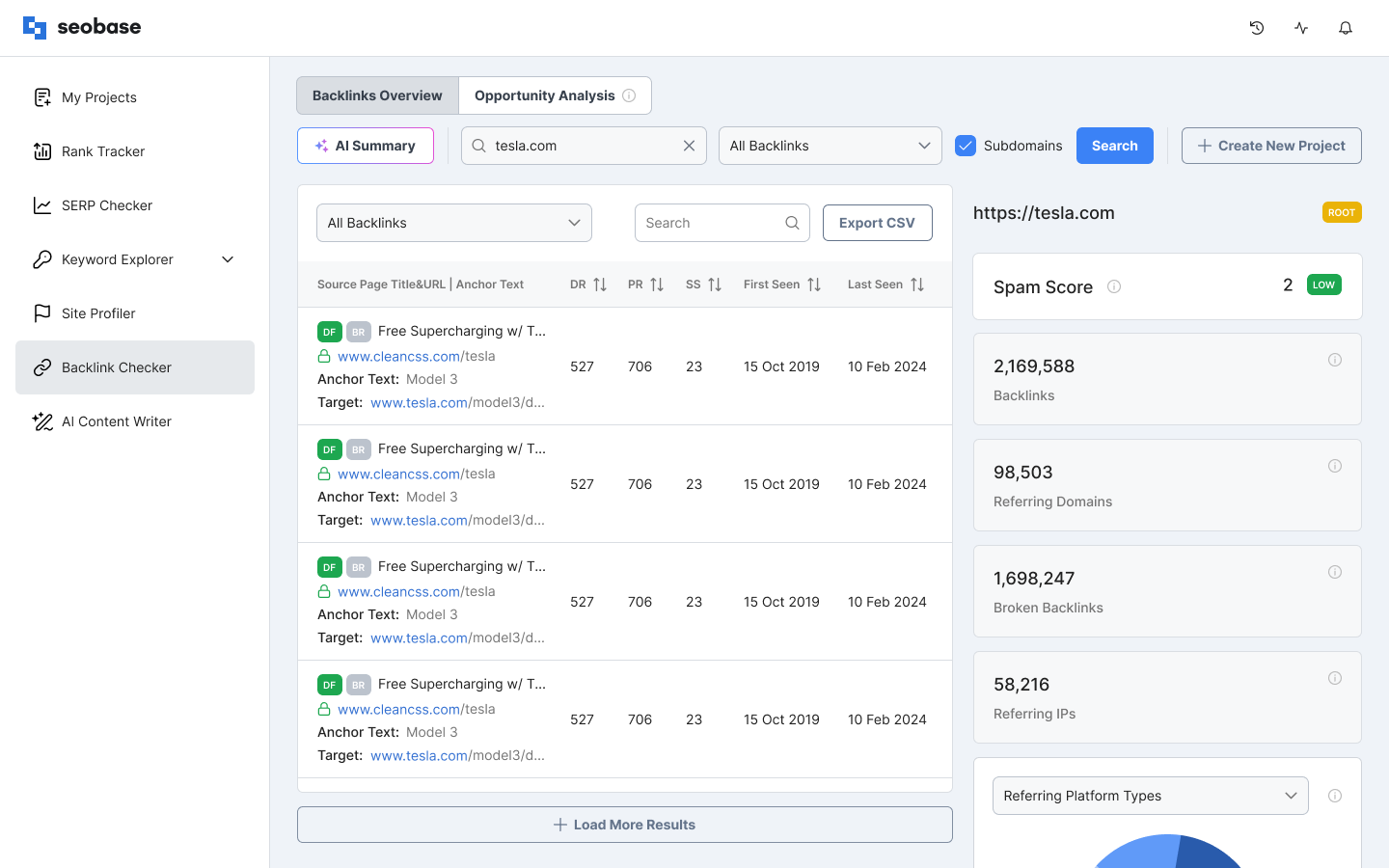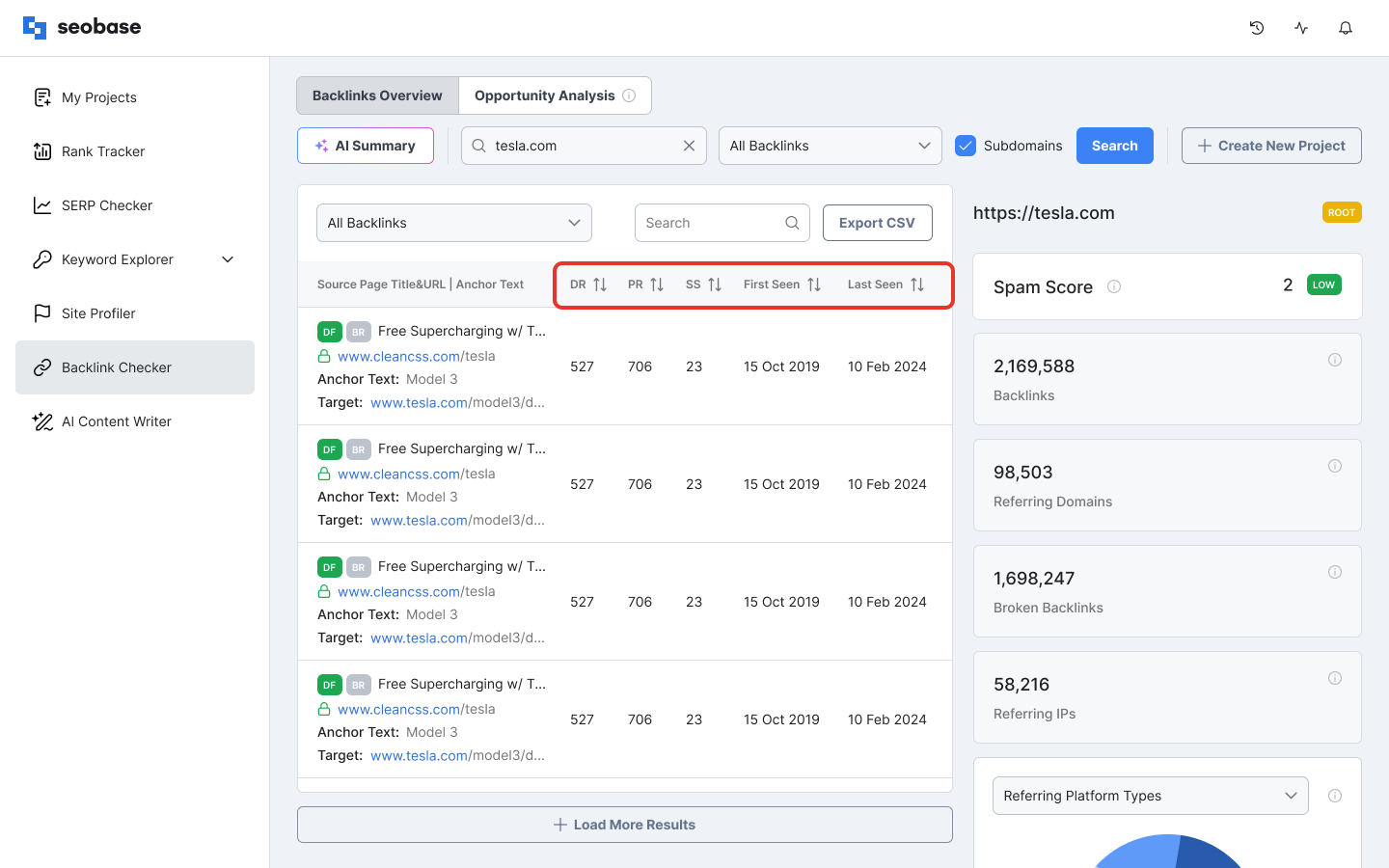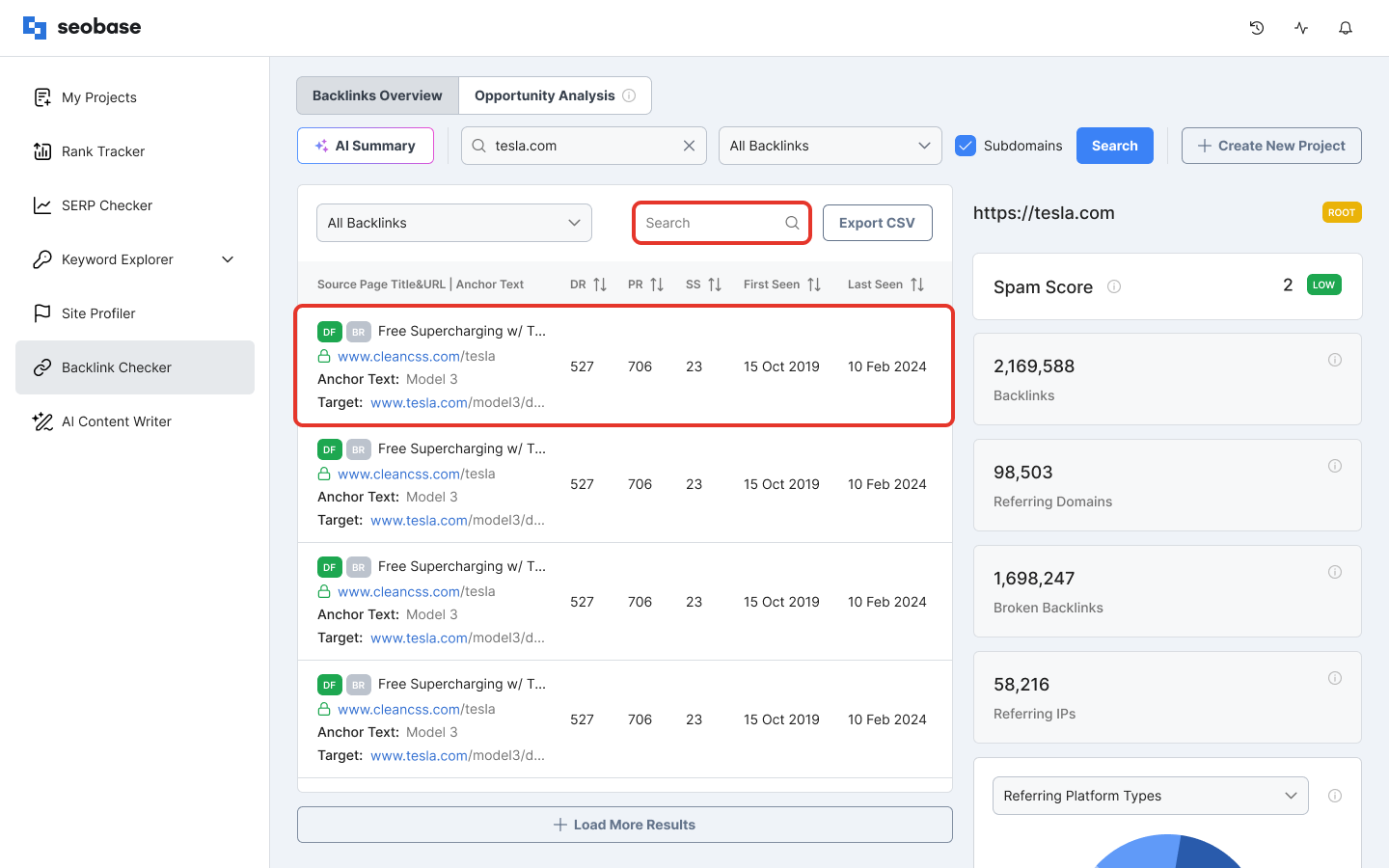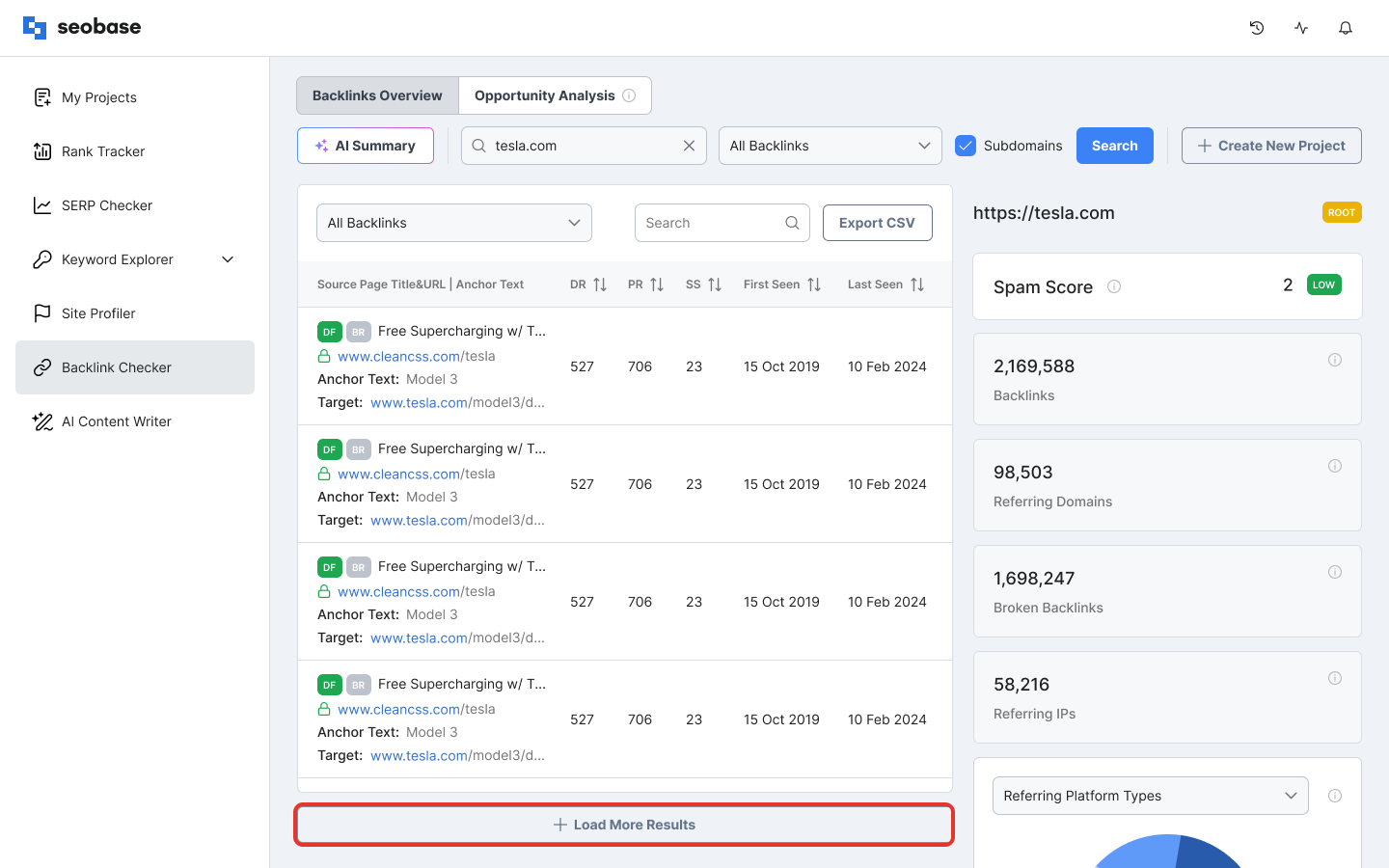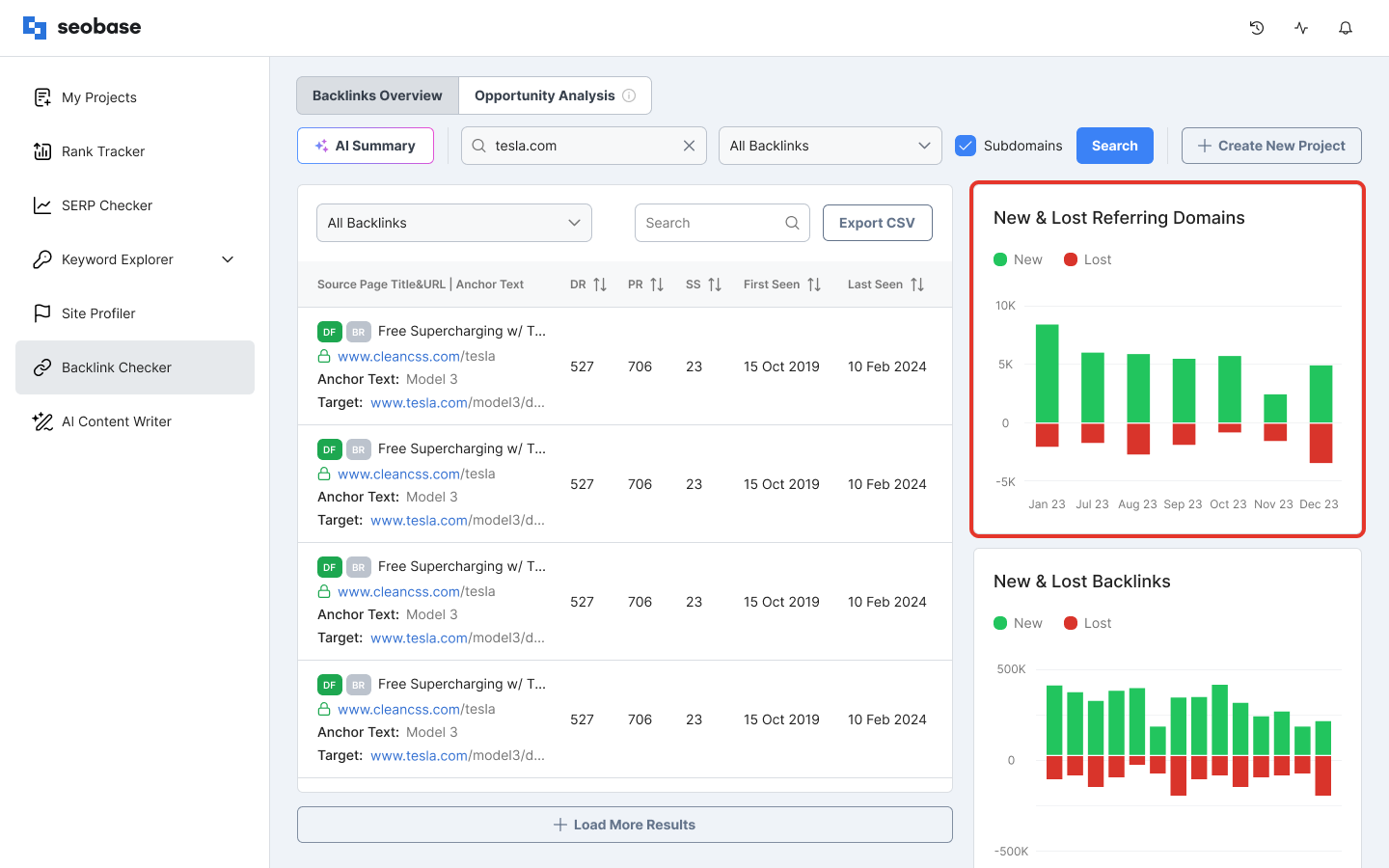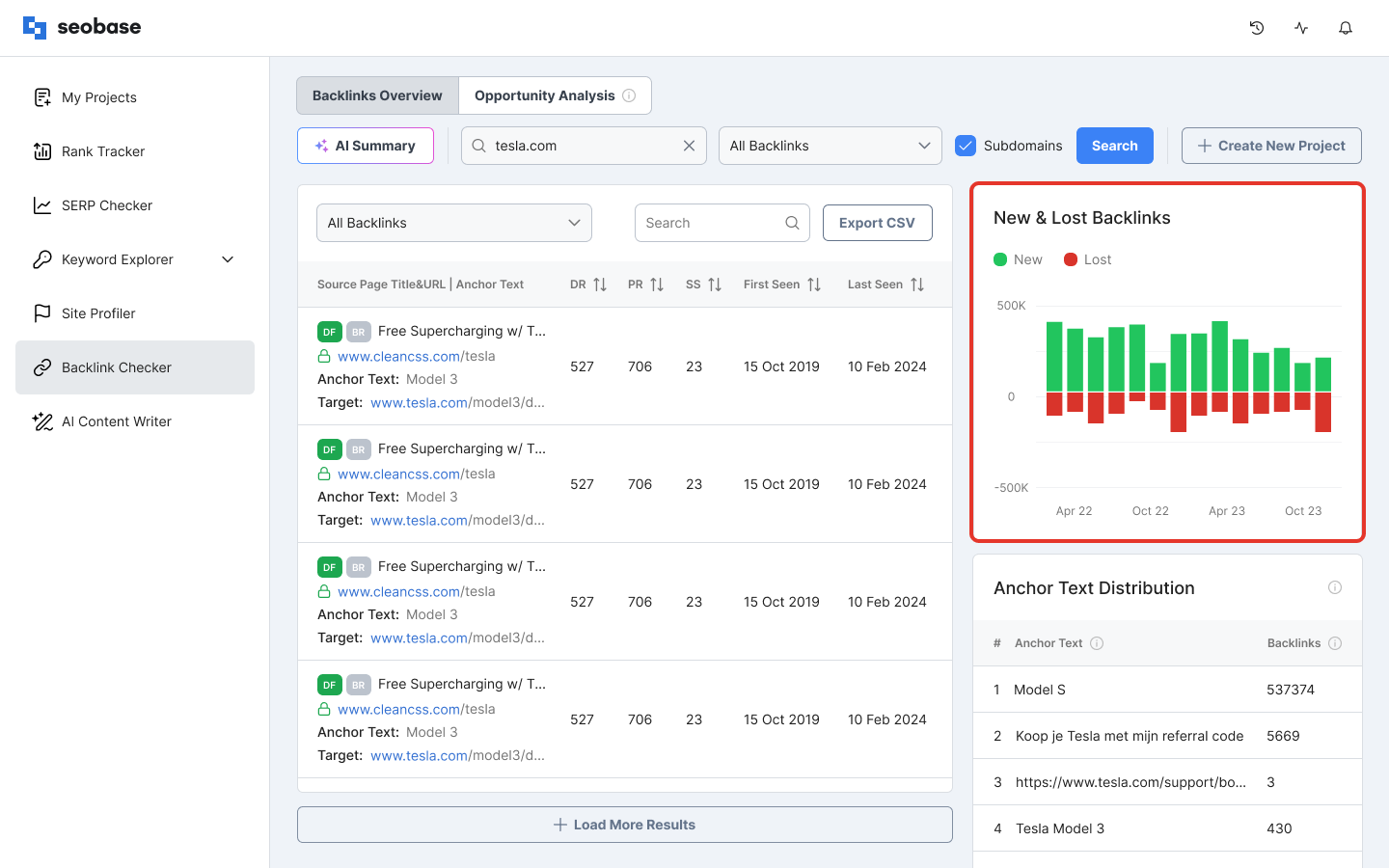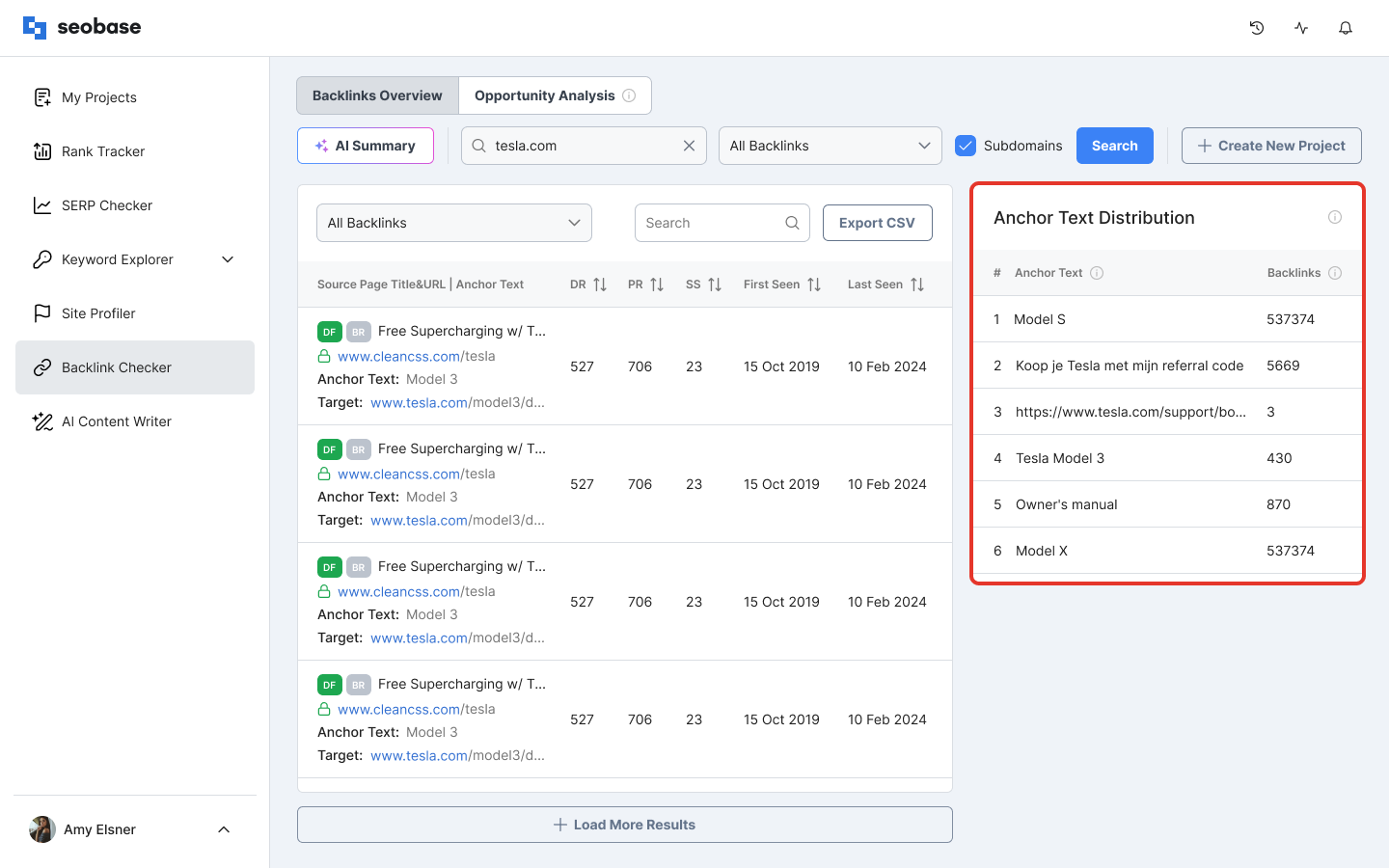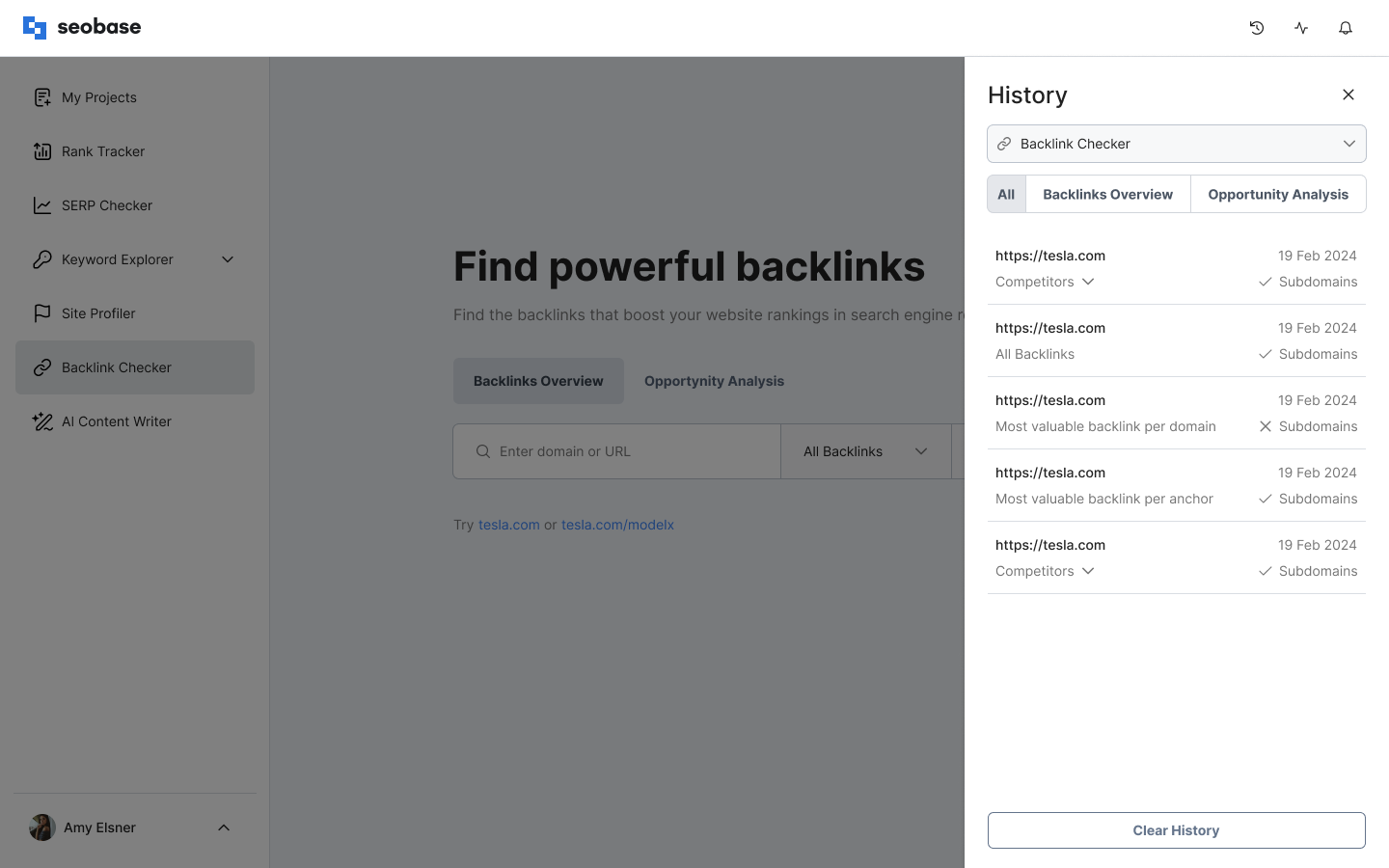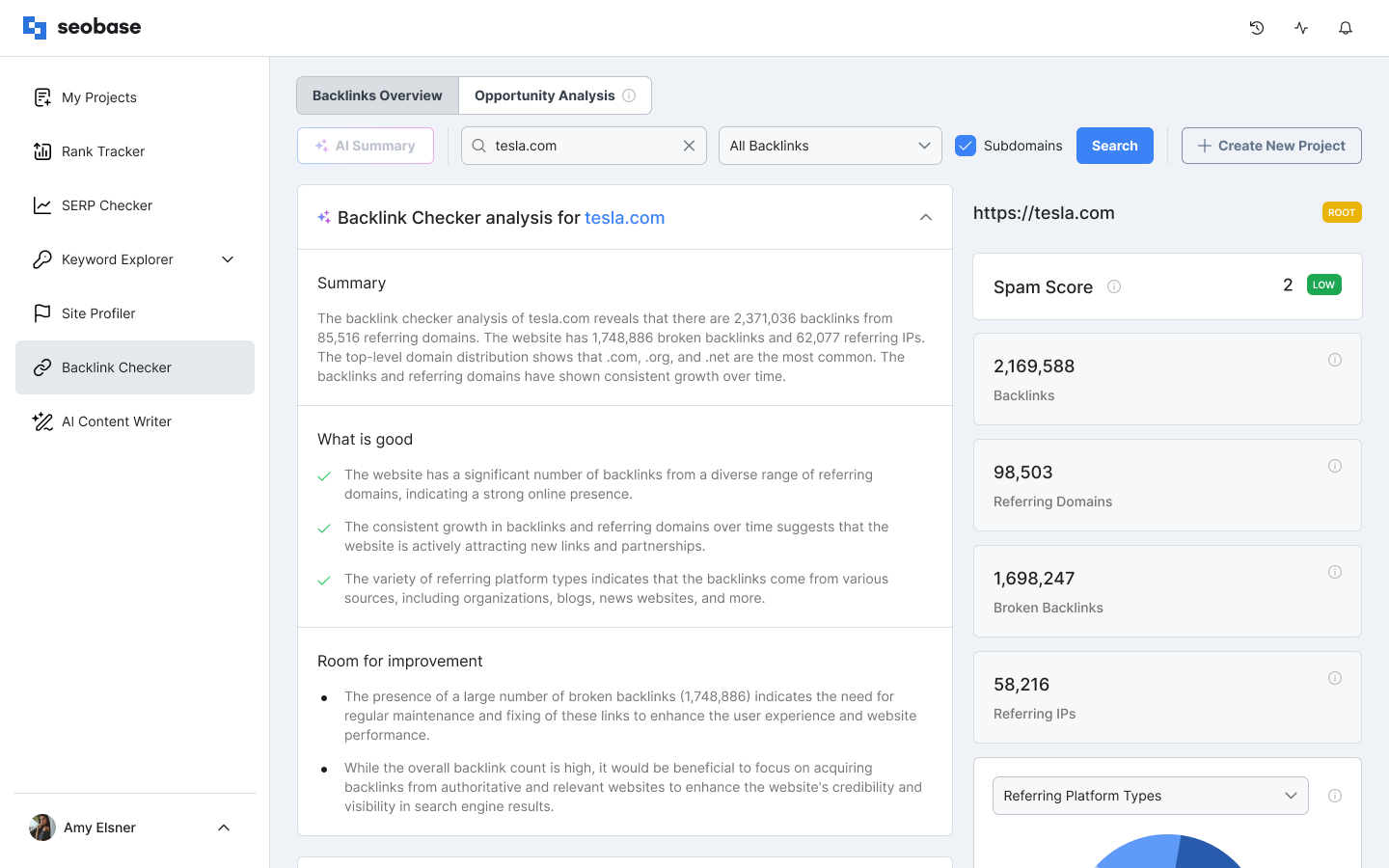How To Use Backlink Checker
You don't need to be an expert or SEO professional to check your backlinks. Instead, it requires a few easy steps:
You can use the backlink checker tool as a single tool or see your website metrics of backlinks in the Project Dashboard from seobase.
As a built-in feature of the project dashboard, the seobase backlink checker tool allows you to monitor your website's backlinks in real-time without switching between different tools or platforms. This helps you stay on top of any changes to your backlink profile and take action to address any potential issues.
Open the URL (https://seobase.com/).
Login to your account or create a new one.
Go to the Backlink Checker page (https://seobase.com/backlink-checker/) or tap on the "SEO Tools" drop-down menu, then pick the "Backlink Checker" menu element, or select the "Backlink Checker" from the dashboard in the bottom of the website.
Enter a domain or URL of the website you want to analyze in the search input field.
Click on the "Search" button or tap the "Enter" button on your keyboard to check the website backlinks. The analysis will take up to 5 minutes to see the overview page results.
The "Overview Page" will be opened automatically when the report is ready.
Select the analysis according to your preference by choosing from the drop-down list and the "subdomains" checkbox on the overview page.
Backlink Checker Features List
The backlink checker overview page will display the backlinks and the referring domains:
Backlinks - the total number of inbound links to this domain from other websites.
Referring Domains - the total number of domains linking back to this website.
Filter and Sort by
The seobase backlink checker tool contains many filters to sort the backlinks by.
The drop-down list includes:
All links - displays the entire links of the website you analyze.
One link per domain - shows only one like per domain.
One link per anchor - shows only one link per anchor.
You will find a "Subdomains" checkbox; check off/on to include/exclude the subdomains.
Also, you'll find another filter in 3 tabs named:
All backlinks - display the whole website backlinks.
DoFollow backlinks - display the dofollow backlinks only.
NoFollow backlinks - displays the nofollow backlinks only. Nofollow backlinks are marked by the letters "NF" next to the intended link.
The more quality followed backlinks the site has, the more trustworthy it is for Google.
Backlinks Overview
In the backlinks overview, you will find:
The Source Page Title - the title that shows up in the Google search for a given URL.
URL - the URL that appears in the website's search bar at the top of the web page.
Anchor Text - the visible and clickable text of the hyperlink.
If you analyzed a website, tabbed on the nofollow tab, and found no displayed data. In this case, you should press the + Load More Results button to get more results, and maybe you can find nofollow backlinks in the following 1000 backlinks.
The Rank Filter
Domain Rank(DR)- This rank is calculated based on the node ranking algorithms used in the original Google PageRank algorithms.
The Domain Rank scale is:
25-35: this score is usually received by newly created domains with small numbers of backlinks.
200-300: this score is usually received by large domains with significant numbers of backlinks from authoritative pages.
+500: this score is usually received by huge domains with significant backlinks from authoritative pages. Very few domains in our database have such rank scores.
Page Rank (PR) - is also calculated based on the node ranking algorithms, the method used in the original Google PageRank algorithms.
Spam Score (SS) - indicates the average spam score of all the pages within the domains and the subdomains.
First Seen - the first time seobase robots could identify the backlink.
Last Seen - the last time seobase robots could confirm the backlink exists.
All the above fields can be sorted differently by clicking on the small arrows beside each one. Those tiny up/down arrows sort the backlinks from the lowest to the highest rank.
Search Input Field
In the search input field, you can search for a specific website to get particular information about this website's backlink and anchor text. For example, you can enter (www.seobase.com) in the search input field and find the selected website details below.
Press the + Load More Information button to get more website backlinks.
Click on the Up Arrow icon to get to the top of the page again.
Referring Platform Types and Top Levels Domains
The total number of referring content management platforms by type will be divided into:
Referring Platform Types, including:
Unknown Domains.
CMS Domains.
Blogs Domains.
Ecommerce Domains.
Wiki’s Domains.
Message-board Domains.
Referring Top Levels Domains, including:
Com Domains.
Net Domains.
Org Domains.
UK Domains.
Info Domains.
RU Domains.
CO.UK Domains.
DE Domains.
CA Domains.
IO Domains.
You can press the "show more/show less" button to control the displayed details.
Backlinks Over Time
The seobase backlink checker visualizes the website backlink numbers into a detailed graph. The graph also displays the Referring Domains.
New & Lost Referring Domains
The backlink checker analyzes the data about the New & Lost Referring Domains (the referring domains that the website earned recently and the ones that have been lost recently) and displays it in a chart divided into two colors:
Green for new referring domains.
Red for lost referring domains.
New & Lost Backlinks
The backlink checker analyzes the data about the New & Lost Backlinks (the backlinks that the website earned recently and the ones that have been lost recently) and displays it in a chart divided into two colors:
Green for new backlinks.
Red for lost backlinks.
Anchor Text Distribution
Anchor Text Distribution - The analysis of the anchor text of your competitors or your website's backlinks. This feature helps you identify which link-building keywords your competitors or your website use the most, referring to your website link.
Anchor text analysis lets you see how your competitors optimize their backlink profiles. Use anchor text analysis to detect potential harmful SEO attacks on your website.
Access History
The seobase backlink checker tool lets you see your previous website backlink checking history.
To check your backlink checker history:
Go to the overview page.
Press on the history icon up-right the page.
After clicking on the "History" button, the modal window is opened from the left side of the screen.
In the list, you can see the history of backlinks checking that contains:
The URL.
Date of search.
You can clear your history by clicking the "Clear History" button.
To close the history backlink checker modal window, just click on the "X" icon.
AI Summary
The AI Summary of the Backlink Checker report is another essential component of seobase's toolkit, offering detailed examinations of a website's backlink profile.
Utilizing AI, it provides a nuanced analysis of backlinks, crucial for search engine rankings:
Quality Backlink Identification: Pinpoints high-authority backlinks that positively impact SEO.
Relevance Analysis: Assesses how relevant each backlink is to the content and niche of the website.
Anchor Text Evaluation: Analyzes the anchor texts used in backlinks to ensure they are keyword-rich and contextually appropriate.
Toxic Link Detection: Flags potentially harmful backlinks that could lead to search engine penalties.
Strategic Backlink Insights: Suggest strategies for acquiring new, high-quality backlinks based on existing effective links' profiles.
The AI feature of the tool can condense this wealth of data into an understandable report, highlighting the most valuable links and suggesting strategies for acquiring similar high-quality backlinks.

